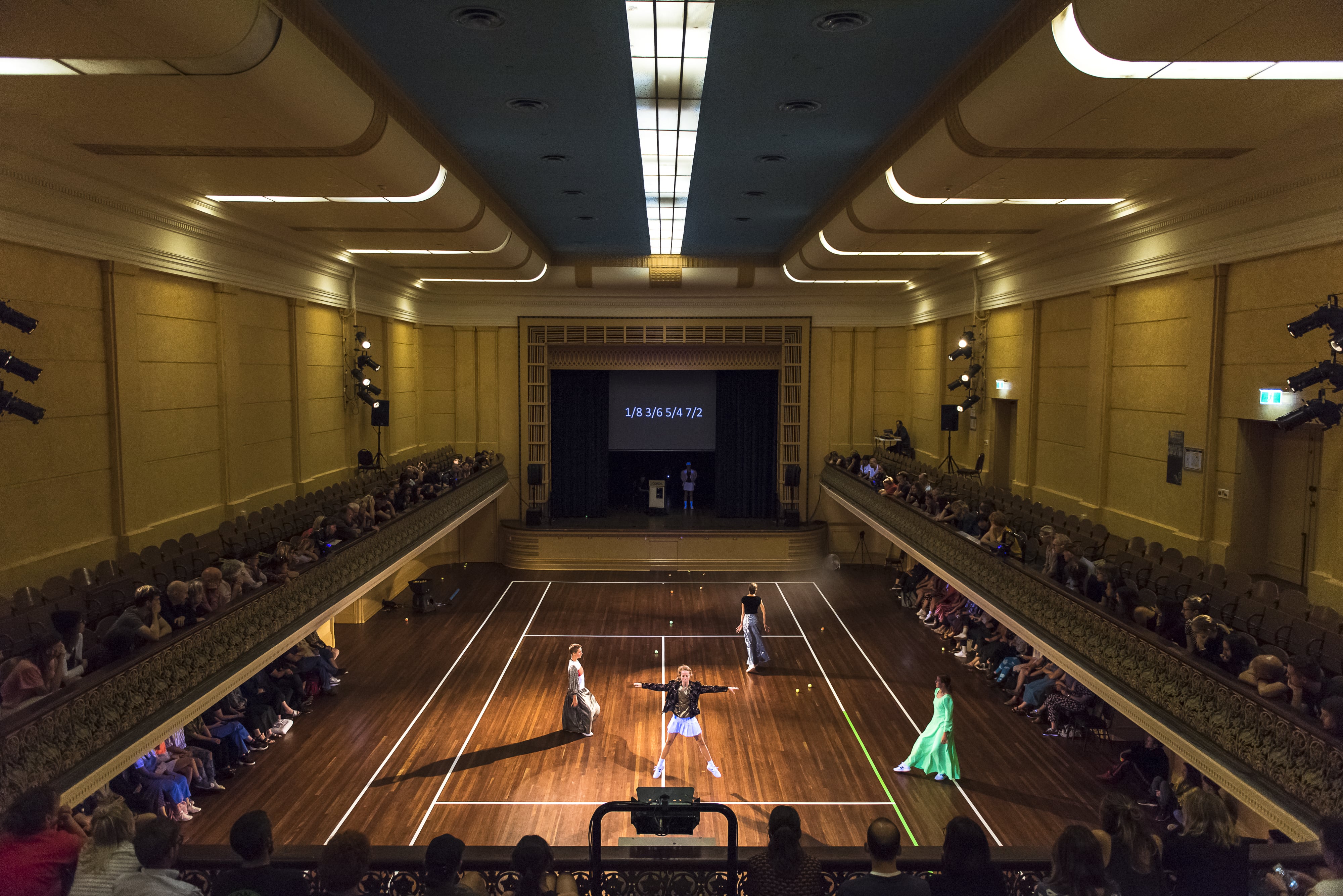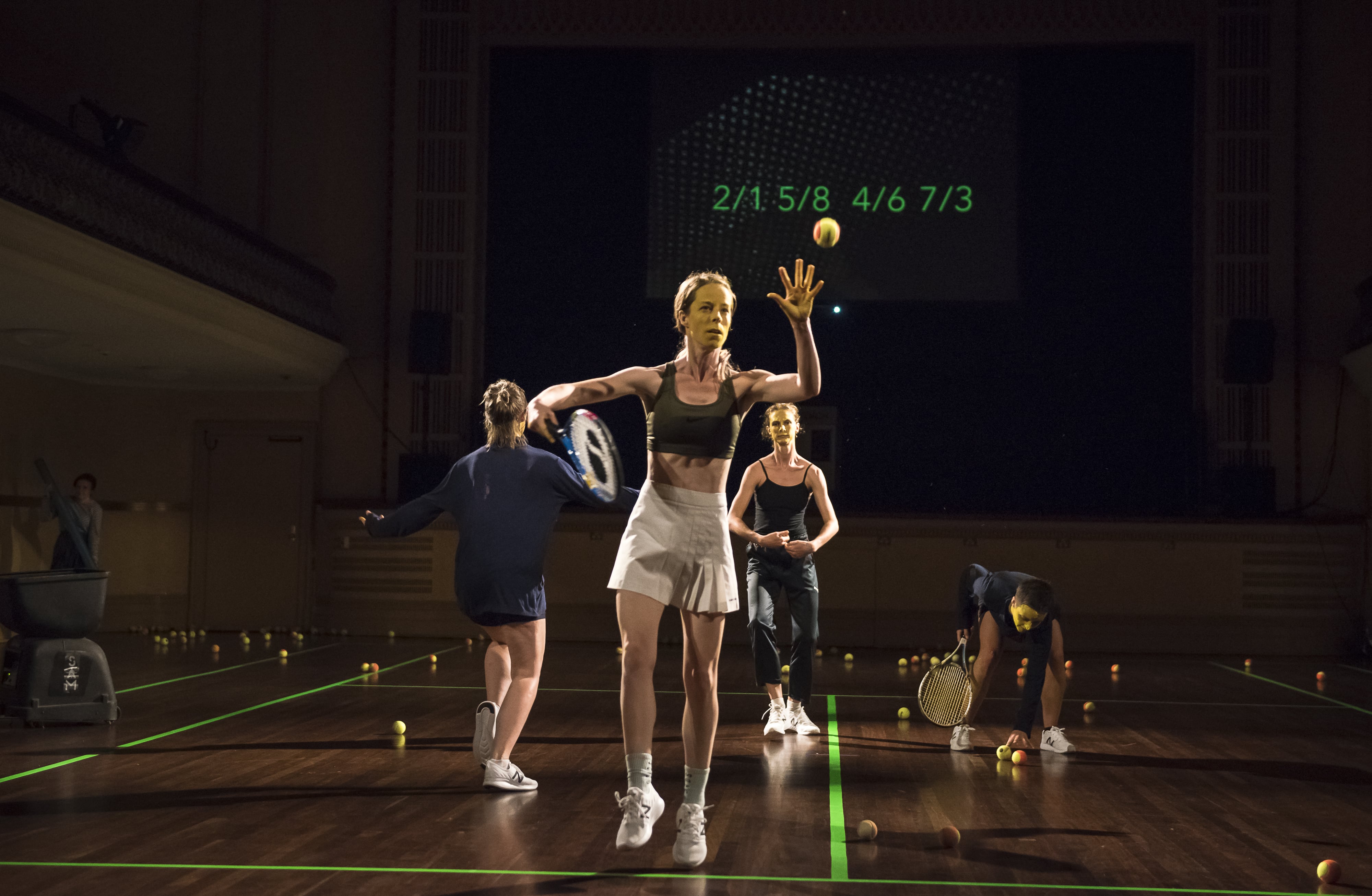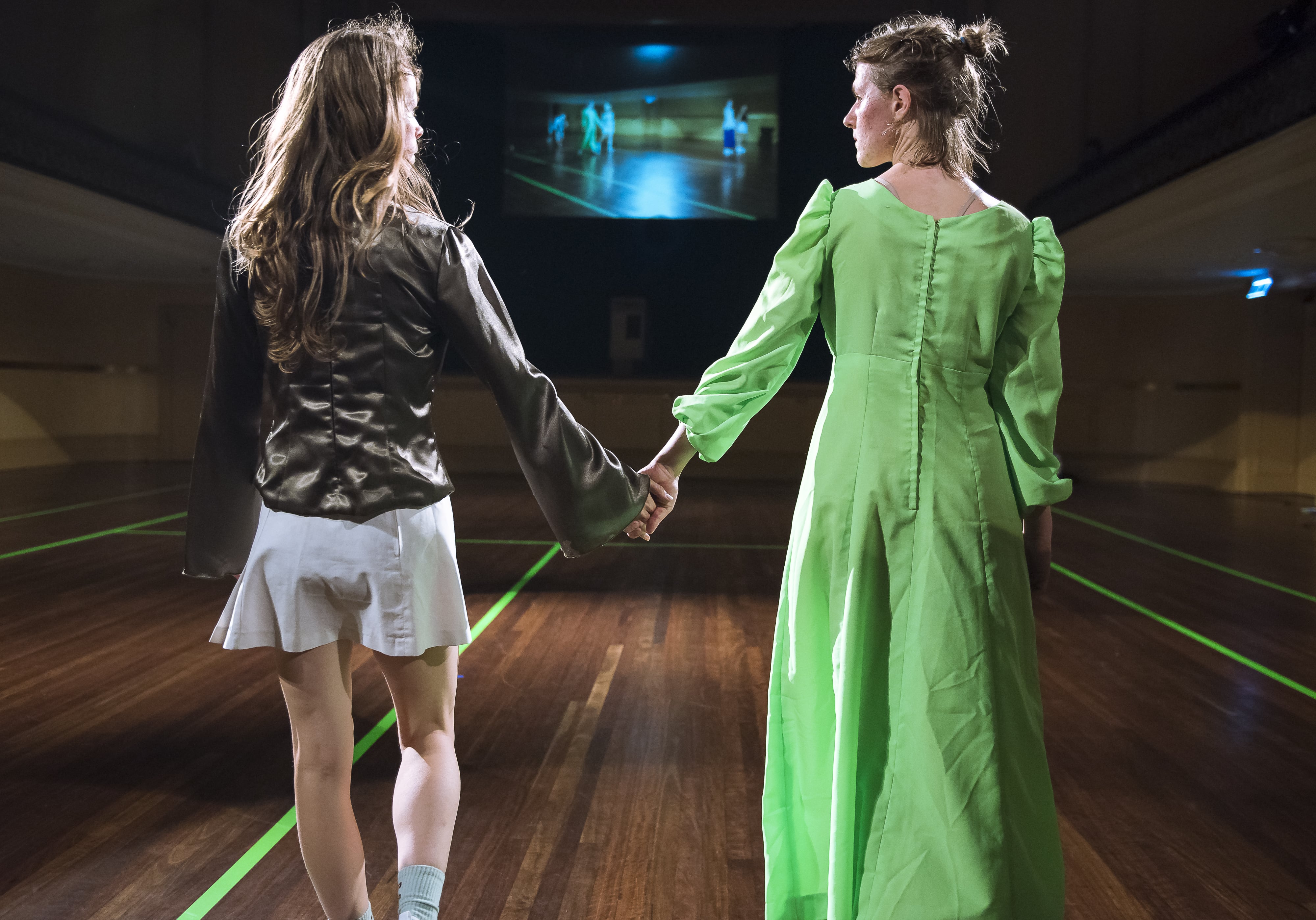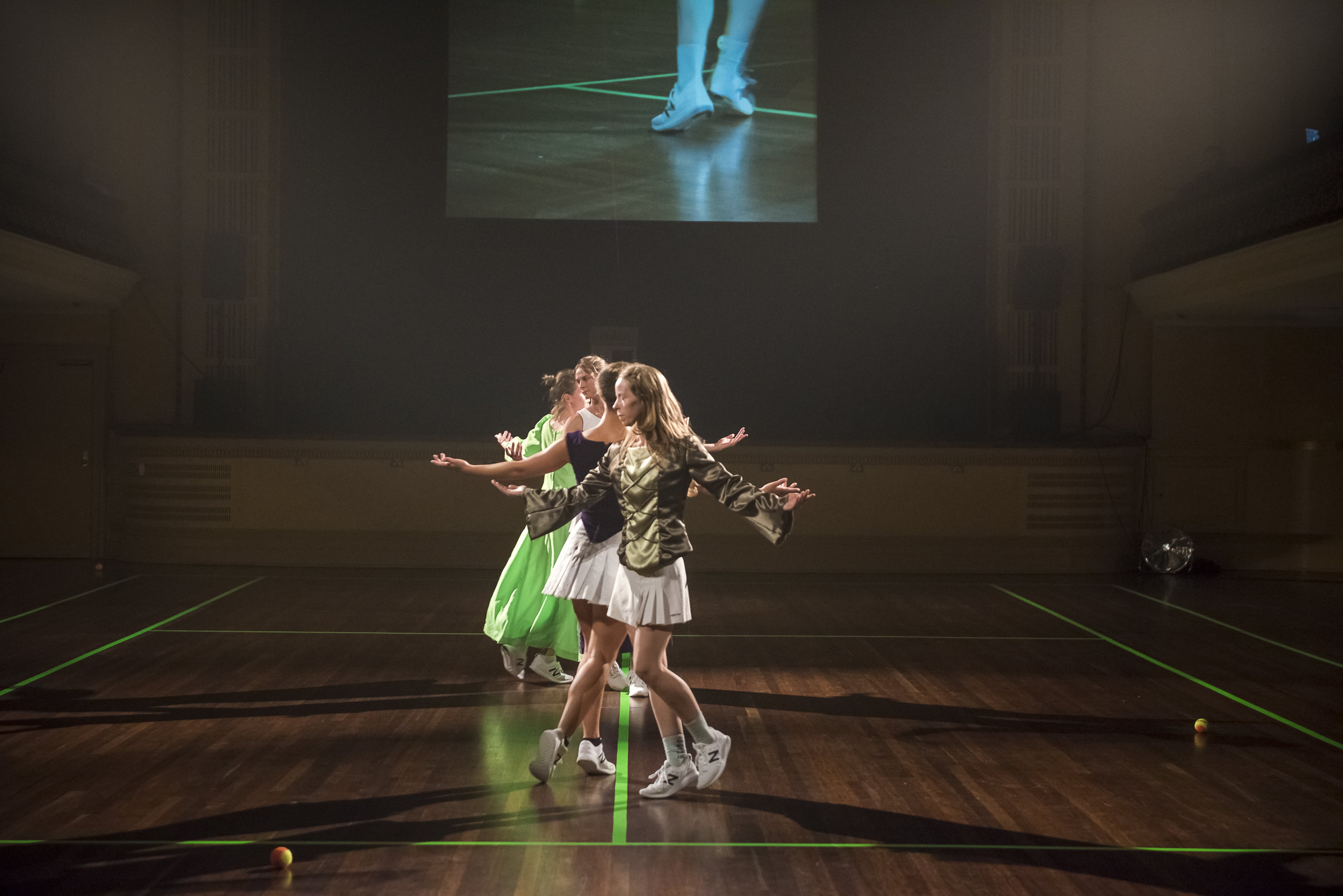



Choreographer: Atlanta Eke
Performers: Atlanta Eke, Ivey Wawn, Annabelle Balharry, Ellen Davies
Music: Daniel Jenatsch
It’s 1789 and 577 deputies of The Third Estate arrive at Versailles to find that their access to the Menus Plaisirs hall has been suspended. Though standing as representatives of all French citizens not granted membership to the first two estates (the clergy and the nobility), these deputies are overwhelmingly members of the bourgeoisie who resent the fact that they are barred by birth and legalities from ascent to the upper-echelons of the social hierarchy. Not to be deterred by this reality, nor that of the locked door at Menus Plaisirs, they instead assemble nearby on an indoor tennis court. Here they take an oath vowing to continue to convene en masse until the creation of a national constitution reforming the estate system is sanctioned by King Louis XVI.
Within the spectre of this event that occurred some 230 years earlier, patrons of Melbourne’s contemporary dance scene gather at the edges of a makeshift tennis court in the Collingwood Town Hall. A game is already underway as we enter the space, with four dancers in tennis whites taking part in a friendly back and forth. The exchange is sound-tracked by Daniel Jenatsch whose score comprises the metallic plunking of a robotic lute and deep, thundering chords on occasion of the balls’ contact with rackets and court. In some respects, the comical juxtaposition of this scene is choreographer Atlanta Eke returning the serve that the Tennis Court Oath’s spatial appropriation initiated. Where in 1789 the tennis court became a parliament, in 2019 Eke turns first a gallery at Gertrude Contemporary, then the parliamentary office of Collingwood Town Hall, into a tennis court. But this inversion is not the only historical reference point Eke is playing with in The Tennis Piece. The work also reaches further back to take on the power play present in Renaissance court dances. Thus, the legislatorial hall becomes the tennis court becomes the royal court as the piece attempts to synthesise times and spaces where movement and its organisation was, and still is, a means of exercising power.
This spatio-temporal blurring is apparent early in the piece as dancer Ellen Davies enters the court in a long, Renaissance-style costume-gown and white tennis shoes. The gown is the same shade of green as the balls the dancers had previously been lobbing back and forth. Davies twirls down the length of the room in a moment wherein the physical attributes of the tennis court blend with those of the royal court. Davies’ movement takes on the pivoting ennui and artificial mannerisms of court dancing, but there’s something a little seditious to this particular adaptation of the open-armed pose. In Davies’ slight relenting to momentum, the external force of the gravitational that such dancing traditionally strives to resist is glimpsed here momentarily. I find myself wondering about notions of lawfulness – in nature, the body – and movements of resistance.
But any development of these considerations is side-lined as the bulk of the piece’s movement becomes reiteratively concerned with the loose imitation and execution of the rhythms and delicate footwork of court dances. Initially this undertaking appears loaded with double meaning as dancers Annabelle Balharry and Ivey Wawn face off from opposite ends of the court, taking turns to execute short phrases, brusquely performing spry balletic movement with all the posturing of friendly but intense competition. The rules of the game are unclear, but there is a legible sense of purpose. Once all four dancers take to the court, the piece loses resolve. Though there is some dynamic variation – at one point the dancers take off around the space at a gallop, pulling at imaginary reigns – for the most part it’s just sombre stepping and turning and springing through a range of genteel gestures. Consequently, the piece’s dramatic conflict is not manifest within the movement itself but in its duration.
The copy for the piece notes that this is to be ‘the unleashing of an explosive new process’ involving ‘4 dancers, 4 tennis ball machines, 400 tennis balls.' Eventually an unleashing of sorts does occur, but as the piece draws on and it becomes apparent that the majority of the work is in fact a consciously monotonous choreography of affected footwork, the tension becomes that of knowing what’s to come and wondering how we will get there. This sense of anticipation only increases as the tedium of the movement grows – the repetitive, looping phrases becoming like a tightly wound coil.
Which brings us with hindsight back to the cusp of the French Revolution, those incensed members of the bourgeoisie and that tennis court. The Tennis Court Oath was not a revolutionary act, but one of reformism. Fundamentally, the demands made by the Third Estate’s National Assembly on 20 June 1789 were an expression of the bourgeoisie’s desire to be seen by the institutional ruling class as worthy of inclusion in existing halls of power. In this way, a piece that takes this historical moment as a central point of reference was perhaps never going to be fuelled by the explosive fury or riotousness of the revolution. Instead, it’s the commitment to constraint and civility that the assembly upheld despite the absurdity of their whereabouts that is echoed by The Tennis Piece.
If crafting an absurdist portrait of bourgeois power play were its intent, the piece might be seen to be a success. Yet it seems like there are other, more consequential ideas – about enlightenment thinking, the infinite, the iterative, the automated – that are gestured towards but never realised within the work. In setting the piece in the town hall, the work’s overarching structure by virtue of location is that of law, order, polite contestation, savvy deflection. But though the imagery is loaded with the possibility for insurrection, as the piece stretches on it becomes clear that the game here is not to challenge such structures. Rather, it’s to play within them. As a result, these bigger, and seemingly more challenging ideas are to Eke’s piece what the revolution was to the Tennis Court Oath – amorphous potential beyond the bounds of the procedural.
This missed opportunity wouldn’t be such a disappointment if not for the fact that a number of other works in this year’s Dance Massive program confidently reached for, and realised more fully, the questions that The Tennis Piece orbits. In particular, Nana Biluš Abaffy’s anarchic Post Reality Vision and Luke George’s interactive Public Action both presented complex visions of how the inherently organisational practice of choreography might produce revelatory states of chaos. Likewise, an earlier version of The Tennis Piece that appeared in Liquid Architecture’s 2017 Acoustic Justice program saw the work’s automated stream of tennis balls released on a narrow walkway at the Melbourne Magistrates Court, so that audience and dancers alike struggled to maintain composure as the projectiles careened into the crowd and off the balcony. Though just a truncated sketch of what the work has since become, this more immediately confrontational iteration of The Tennis Piece came closer to seizing on what it means to go through the motions and, moreover, what it means to conceive rules that dictate particular motions be carried on in some future that is largely unforeseen. It’s because of this that I hope 2019’s The Tennis Piece is, like its 1789 forbearer, a pledge to continue to reconvene. Because the ideas Eke has raised here are potentially game-changing, but as The Third Estate later discovered, the radical may only be realised by shedding the bonds of pageantry and demanding more.
ELyssia Bugg is a freelance writer and critic living in Melbourne, Australia.
